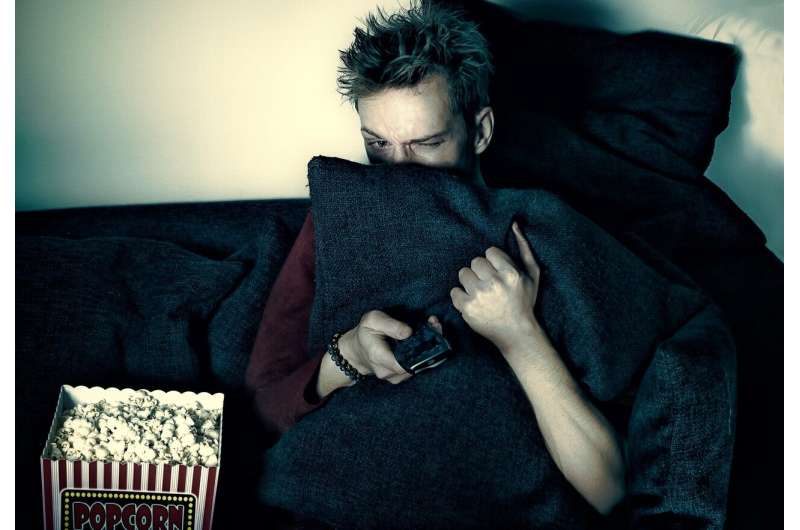This article has been reviewed according to Science X's editorial process and policies. Editors have highlighted the following attributes while ensuring the content's credibility:
fact-checked
trusted source
written by researcher(s)
proofread
What makes a film score frightening? Expert explains the techniques that build tension and make us jump

Think of the scariest film you've ever seen. Beyond any blood-curdling screams or pounding heartbeats, there's sure to be another sound that sticks in your memory—the score.
Perhaps that's the shrieking strings of Psycho (1960), or the pulsing piano melody and ominous bass of the Halloween franchise (1971-2022). Maybe it's the eclectic score for Suspiria (1997)—which combined instruments including synthesizers, Greek bouzouki, Indian tabla and whispering voices.
Or does The Shining's (1980) unsettling quotations of music by avant-garde composers like Ligeti and Penderecki still haunt your nightmares?
Horror films incorporate varied musical influences. But there are some devices that they share with successful scary or tension-inducing scores in other genres, including thrillers and contemporary action films. These devices help the creation of an ambiguous musical atmosphere.
This feeling of uncertainty is frequently achieved through a lack of conventional melody and dissonant (clashing) harmonies that do not readily resolve. Repeated short melodies instead convey tension, as do tremolo techniques (sounds that are literally trembling or quivering), involving rapid reiteration of a pitch or alternation between two pitches.
These features shape audience expectations through repetition, creating unease when anticipated development fails to emerge. The entry of additional instruments, increasing volume or regularity of the repetitions, or sequential rising of pitch with each iteration, can all escalate the tension—partly by not promoting substantial melodic evolution.
The science of a scary score
Composer Bernard Herrmann's music for Psycho's shower sequence is a quintessential example. It shuns melody for repeated high-register violin pitches and builds by gradually adding strings to expand the dissonant underlying chord.
Similar techniques are also commonplace in more recent thriller scores by composers like Hans Zimmer. Take Inception (2010), for example, with its recurring guitar motif and building, dissonant, string stabs.
Researching scary scores
Drones (sustained notes or repeated figures) also effectively help shape tense atmospheres. These often appear in the bass, sometimes alongside low frequency rumbling. This can be heard in the recent Oppenheimer film (2023), during scenes surrounding the Trinity Test. These drones convey space and ambiguity, given the void between them and any high melodic fragments.
Music researcher K.J. Donnelly sees a connection between these pitch extremities in horror film soundtracks and bodily sounds. The high string lines in soundtracks to film such as Psycho acoustically imitate the "roughness" or harsh qualities of screams. Whispered or shouting voices often feature in horror scores, as do sounds emulating the human heartbeat.
Yet, while these sounds emphasize the physical and vulnerable, the frequent use of electronic instruments and blurring of music and sound design also creates ambiguity which evokes technology and the inhuman. This can be heard in Oppenheimer's use of ticking sounds from the Geiger counter, a device used to detect radiation.
Contrasting these ambiguous sonic atmospheres, sudden loud bursts of sound or music (stingers) that work like jump scares also often feature. Donnelly describes these sounds as "primal", mirroring psychological work that lists brainstem reflex (instinctive responses to sudden sonic events), as one musical means of inducing emotion.
Strong musical bursts alongside, and prior to, visual shocks in horror films have been shown to increase stress responses in viewers. Sudden silence can work similarly, as in Oppenheimer during the test-detonation of a nuclear bomb. Likewise, the piercing violin entry in Psycho's shower scene is heightened by the preceding lack of music.
Using musical features in unfamiliar settings also subverts expectations—and in horror films juxtaposes the innocent and familiar against dark content.
References to religion and childhood are invoked through instruments like the organ and music box, and allusions to hymns and lullabies. Similarly, incongruent lively or nostalgic preexisting music can be used to engage or distance audiences. One example is when Olivia Newton-John's Over the Rainbow accompanies a gunfight in the action-thriller Face/Off (1997).
Such musical techniques impact us physically and psychologically. Film music scholars have noted this for many years, but in recent decades psychology researchers have started to empirically explore how.
While these devices may not feature in every tension-inducing scene, chances are at least some have contributed to any increased heart rate, goosebumps, or startle responses you have experienced. Such reactions are one key reason why we keep returning to scary films and clearly demonstrate the emotional impact of film music.
Provided by The Conversation
This article is republished from The Conversation under a Creative Commons license. Read the original article.![]()





















